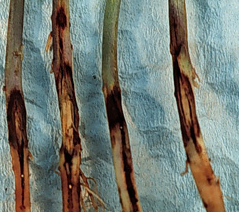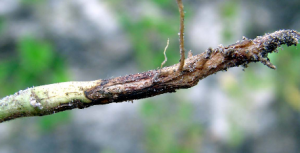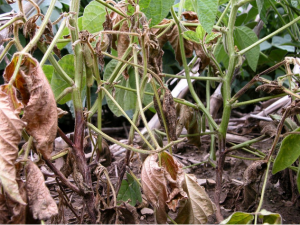Article originally posted on the Bulletin.
With the storm that moved through the state the past week, it is not surprising that we are seeing more seedling diseases in soybeans. In many cases Rhizoctonia has been identified as the causative organism, alone or in combination with other soil issues such as compaction. Rhizoctonia is one of the most common and problematic seedling issues for soybean producers in Illinois, and can cause significant yield losses due to stand reduction and reduced plant growth. In addition to killing germinating and emerging seedlings, Rhizoctonia can produce stem cankers. Cankers are sunken lesions that are typically located at or near the soil line, although sometimes they can extend a couple of inches up the lower stem. Large cankers can severely reduce the translocation of water and nutrients up the stem, causing the plant to wilt and potentially die. Affected plant tissues tend to appear reddish-brown and will have a corky, almost dry-rotted look to them. Rhizoctonia typically appears in patches, and is most problematic when soils are moist and warm. Seed treatments with active ingredients that are effective for Rhizoctonia can be effective for reducing early infections. However, these products are only effective for the first week or two after planting, and are unlikely to impact disease occurring later in crop development. Varieties differ in their tolerance, but there is no resistance to Rhizoctonia.

Rhizoctonia cankers on lower stems of soybeans. Image Credit B Nelson.

A characteristic canker on the lower stem of a soybean plant. Image CPN.
Another pathogen that we may start to see more of in the upcoming days is Phytophthora. Phytophthora lesions on stems are black to brown and extend from the roots up the lower stem of the plant. Margins are not as defined as in Rhizoctonia-infected plants, and lesions are soft and mushy. Phytophthora is a water mold and is favored by wet, saturated soils. When soils are saturated and warm, the overwintering structure of this pathogen germinates, producing another structure that releases small spores into soil solution. These spores have tails, or flagellae, that propel the spores in the water. Then, the spores sense gradients in chemicals from plant roots to locate and infect root systems. A video of these spores in action can be found by clicking here. Phytophthora tends to be found in low lying, poorly drained areas of the field.

Phytophthora stem lesions on soybean. Image CPN
Management of Phytophthora starts with the selection of a resistant variety. There are two types of resistance available for management of Phytophthora, race-specific (Rps) and partial. Race specific is similar to a door that will completely block specific types of Phytophthora from infecting plants. However, some individuals contain a key that allows them to open that door and infect roots. Thus, if a variety with an Rps gene (door) is planted into a field with a Phytophthora population that is comprised of individuals able to overcome (key) that resistance, you may still see significant infection. The most common Rps genes are Rps1a, Rps1c, Rps1k, Rps3a, and Rps 6. Although many varieties only have a single Rps gene, some have multiple, or stacked Rps genes. Partial resistance acts like bouncers guarding the stage at a concert. They provide some resistance to all populations of Phytophthora, but some disease, typically less and developing at slower rates, can be caused (rowdy fans who eventually jump on stage, only to be pulled off soon thereafter). Partial resistance is not expressed until later in plant development, typically after V1, and therefore are not effective for managing early infections. Like Rhizoctonia, seed treatments can provide benefits early in the season. It is important to realize that Phytophthora is not a true fungus, but an oomycete, and therefore seed treatments must contain oomycete- specific active ingredients (e.g. metalaxyl, mefanoxam, ethaboxam).


 and then
and then